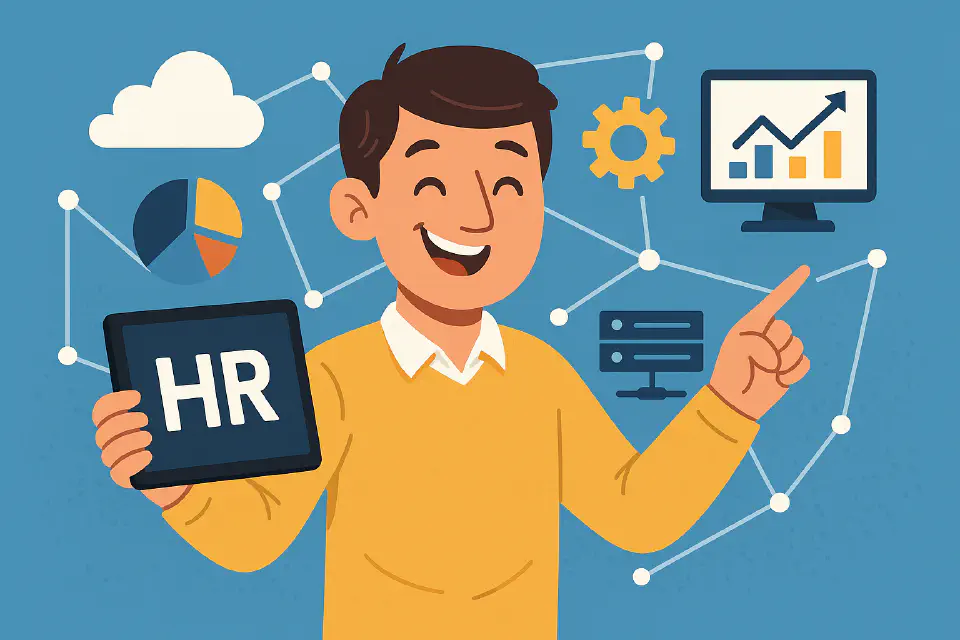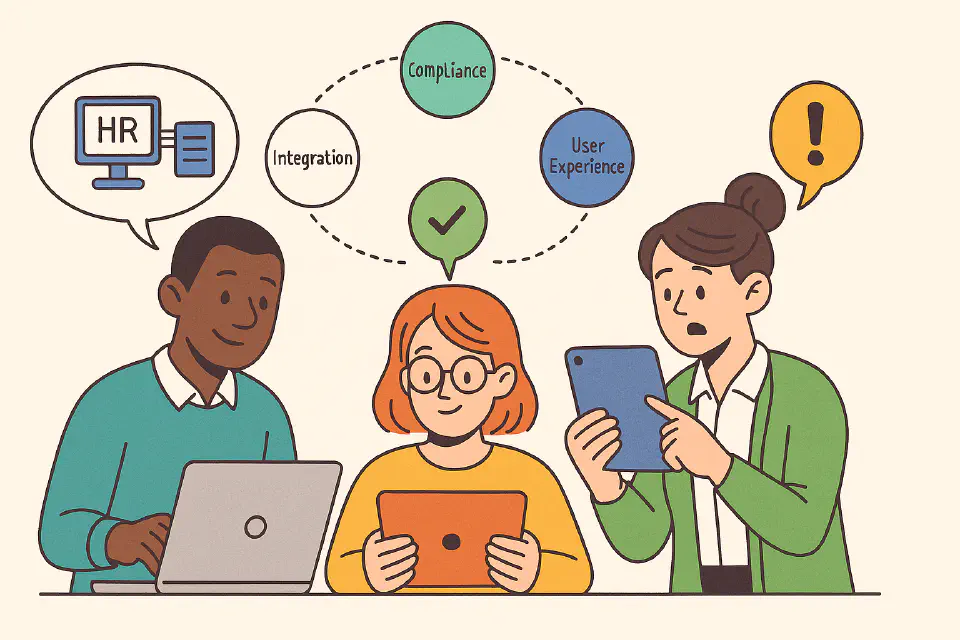
HR as a Technology Integrator
Digital tools don’t transform HR — people do. This page explores how HR acts as a technology integrator: choosing the right tools, aligning them to strategy, and ensuring they empower managers and employees alike.
Why Technology Integration Is Now a Core HR Role
Organizations today rely on a growing ecosystem of tools to manage the employee experience:
- Applicant Tracking Systems (ATS)
- Learning Management Systems (LMS)
- Employee Experience Platforms
- People Analytics Dashboards
- Chatbots, self-service portals, automation flows
But having tools is not the same as having impact.
HR’s role is to translate business needs into digital solutions — and then ensure those solutions are adopted, useful, and integrated into real workflows.
Technology Without Integration Fails
The average HR function now uses over 10 separate platforms. Yet in many organizations:
- Systems don’t talk to each other
- Adoption rates are low
- Data is fragmented and underused
This leads to friction, waste, and missed opportunity.
Strategic Responsibilities of HR as a Technology Integrator
1. Technology Needs Analysis
- Engage users: What problems do employees and managers face?
- Align to goals: How will tech support strategy, not just process?
- Audit existing tools: What’s used, what’s working, what’s wasting?
2. Solution Selection and Procurement
- Partner with IT and vendors
- Prioritize user experience (UX), integration capability, scalability
- Think modular: Avoid all-in-one bloat, embrace open architecture
3. Implementation and Change Enablement
- Create cross-functional rollout squads
- Provide bite-sized training, demos, champions
- Integrate into workflows — don’t ask users to log into “one more tool”
4. Governance and Iteration
- Own vendor relationships, roadmap discussions
- Collect usage analytics and feedback
- Run regular retrospectives and release cycles
A Deeper Look: From Digitization to Digital Transformation
To understand HR’s role in tech integration, it helps to distinguish between three levels:
- Digitization – Converting paper to digital (e.g. storing contracts as PDFs)
- Digitalization – Automating and optimizing processes (e.g. automating onboarding flows)
- Digital transformation – Rethinking the way HR creates value using technology

When HR acts as a technology integrator, it operates primarily at level 2 and 3 — designing workflows, shaping systems, and embedding data-driven decision-making.
HR Technology and the Employee Experience
Technology is most powerful when it supports how employees actually experience work. HR should focus on high-impact journeys:
- Onboarding: Digital welcome kits, buddy systems, role-specific content
- Performance & Feedback: Integrated goal setting, feedback nudges, manager dashboards
- Development: Learning recommendations tied to roles, certifications, career paths
- Internal Mobility: AI-based matching, skills visibility, promotion transparency
- Exit & Alumni: Digital offboarding, feedback loops, alumni communities
Each touchpoint is a chance to remove friction, build trust, and reinforce culture — if tools are designed with the user in mind.
Decision Frameworks for Tech Investment
HR leaders are often overwhelmed by vendor pitches, overlapping tools, and pressure to “go digital.”
A strategic decision framework helps evaluate:
| Factor | Key Questions |
|---|---|
| Strategic Fit | Does this tool support a priority business or people outcome? |
| User Experience | Will employees and managers find it simple, helpful, and engaging? |
| Integration Potential | Can it connect with existing systems and data layers? |
| Scalability | Can it grow with us, across regions or business units? |
| Vendor Partnership | Are they investing in roadmap, service, and long-term innovation? |
Embedding a Culture of Digital HR
Technology integration isn’t a one-off project — it’s a capability HR must embed.
To do that:
- Develop digital mindsets in HR teams (e.g. design thinking, agile)
- Celebrate quick wins and publish impact stories
- Set goals for adoption and usability, not just go-live
- Partner with business leaders to co-own outcomes
Examples of HR Tech Integration Done Right
Case 1: Streamlining the Hiring Funnel
A global retailer integrated its ATS with onboarding and payroll systems. HR:
- Reduced manual entry by 85%
- Enabled real-time status tracking for hiring managers
- Created a seamless candidate-to-employee handoff
Result: Time-to-start dropped from 14 to 7 days. Candidate satisfaction scores rose 26%.
Case 2: From LMS Chaos to Learning Ecosystem
An engineering firm used 4 separate LMS tools. HR consolidated platforms, introduced a learning experience layer, and connected L&D content with performance reviews.
Result: Learning completion rates tripled, and 1:1s now routinely discuss development goals using shared dashboards.
Case 3: Embedding Self-Service and Chatbots
A healthcare provider launched an HR chatbot for common questions:
- Leave balances
- Policy access
- Referral bonuses
Result: HR ticket volume dropped 42%. Employees rated the bot 4.4/5 for usefulness.
Capabilities HR Needs to Integrate Technology Effectively
| Capability | Why It Matters |
|---|---|
| Digital Curiosity | Explores trends, tools, and emerging platforms |
| Process Design | Maps workflows to ensure tech fits the way work happens |
| UX Empathy | Advocates for intuitive, frictionless design |
| Data Fluency | Uses metrics to track, explain, and improve adoption |
| IT Collaboration | Builds trust with tech teams and vendors |
HR Tech Integration Maturity Model
| Stage | Characteristics |
|---|---|
| Fragmented | Tools are siloed, few integrations, low adoption |
| Coordinated | Some systems talk, but experiences vary; analytics are manual |
| Unified | Platforms integrated around workflows; consistent UX and data access |
| Intelligent | HR tech actively recommends, automates, and adapts to user behavior |
Best Practice: Think in Journeys, Not Systems
Final Thought
Digital HR is not about tools. It’s about trust, timing, and transformation.
HR’s power as a technology integrator lies in its ability to translate complex systems into simple experiences — and turn disconnected data into shared insight.
When technology supports how people actually work, HR doesn’t just digitize processes. It amplifies impact.